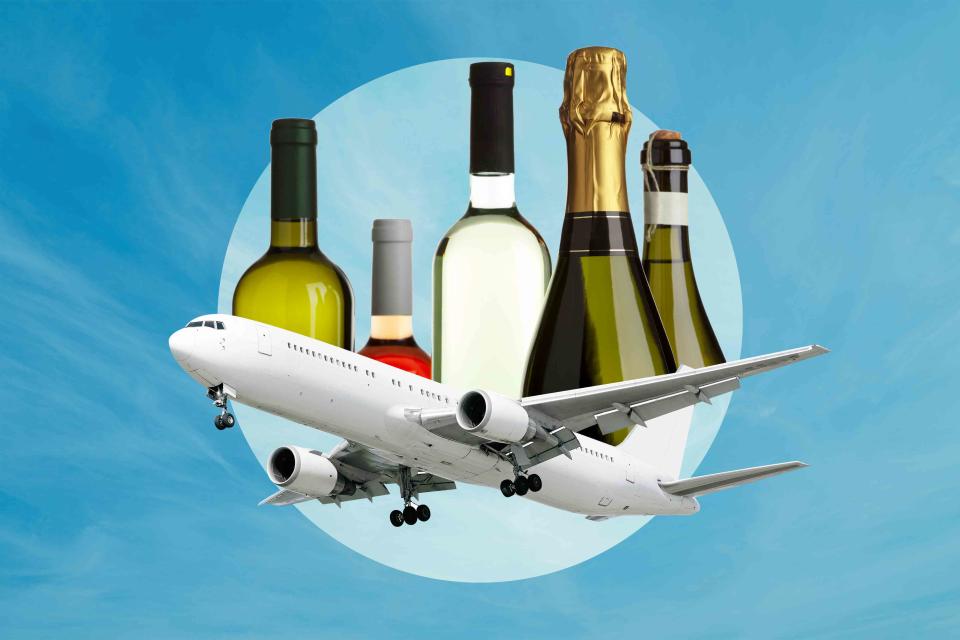Why You Should Never Drink on Long-Haul Flights, According to Science
Perhaps skip that in-flight negroni.

Food & Wine / Getty
You’ve had a good year. You and your significant other are about to board that long-haul flight to your well-deserved salmon-fishing vacation in Scotland, where you’ll be pampered just like King Charles in a real Scottish castle — with its own river, no less. Your wellies, your waders, and your fishing kit are on the plane. Next stop, Edinburgh and on to the wild Highlands. In the lounge with time to kill, you two decide to toast embarking on this adventure by ordering up a round of delicious Johnnie Walker Black on ice. Scotland, right? A wee dram, as the Scottish say, puts you in the spirit. Literally.
So, you may not want to hear from these other really smart and interesting people right in the teeth of your getaway moment, but Cologne’s Institute for Aerospace Medicine has some sobering news for you — and they mean that literally: Don’t drink the firewater, baby! Save it for the bar in the castle! You’ve paid so much for the beat on the river that the castle will be comping your drinking anyway!
Related: How to Pair Airline Snacks and In-Flight Cocktails, According to Bar Pros
According to a recent study published in the British medical establishment’s terrifyingly-titled scientific journal Thorax, it turns out that drinking alcohol in hypobaric environments lowers your oxygen levels and increases your heart rate simultaneously, even, or especially, when you are subsequently reclining to nap — an inevitability on long-hauls for everybody. In fact, the question is not who drinks and naps on long hauls, but is its reverse: Depending on your trek, faced with six to twenty hours aloft, who doesn’t have a glass of wine and then try to take a nap?
For those of us who are on the far side of the meridian with aches, pains, and ailments as part of our carry-on body baggage, so to speak, drinking while flying does us all worse. The Cologne researchers have proven that pre-flight or inflight alcohol, even as little as a two beers’ worth, triggers that twinned, simultaneous spike-in-heart-rate and drop-in-oxygen-saturation in 100% of their subjects, no matter their age or condition.
Related: Here's Why Your Senses of Smell and Taste Change Radically When You Fly
There’s precious little silver lining here. Depending on what and how serious our conditions or ailments are — but especially if they are pulmonary and/or cardial — then the danger of the heart-rate spike alongside the drastic lowering of oxygen levels enables the body to manufacture what medics will dryly describe as a cardiac “event.” In a word, our bodies are opportunistic, like everything else in nature.
If there’s a weak link down in the ticker, and the conditions arise to make it “easy” for someone’s heart to exhibit malfunction based on that vulnerability, it will do that. With the alcohol-induced “conditions” that those couple of pops (or more) have created in your body on a (hypobaric) long-haul, the percentage of likelihood for that event increases.
Depending upon which signature pre-existing health vulnerability you’ve brought aboard, drinking before flying (or inflight) manufactures what we can describe as ideal “storm conditions” out of which the body can call a much larger and more life-threatening acute condition to the forefront.
Related: The Real Reason You Shouldn’t Order Coffee or Tea on an Airplane
As our friends in Cologne note, 58% of inflight diversions or emergency landings are the result of heart attacks. That’s grazing the bottom side of two-thirds, an incredibly large percentage. Not that your pre-flight whisky is going to bring that on this time around.
But still: A nascent heart attack is the hurricane theory written inside your body, with alcohol playing the role of the hot, dry westerly trade winds blowing off the Sahara toward the Caribbean. They make it easy for the storms to form.
In a word, dang! It’s gonna be a long, dry flight.
For more Food & Wine news, make sure to sign up for our newsletter!
Read the original article on Food & Wine.


